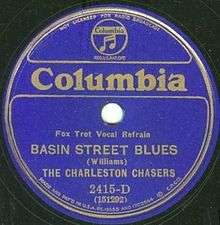Basin Street Blues

"Basin Street Blues" is a song often performed by Dixieland jazz bands, written by Spencer Williams. It was published in 1926 and made famous in a recording by Louis Armstrong in 1928. The famous verse with the lyric "Won't you come along with me/To the Mississippi..." was later added by Glenn Miller and Jack Teagarden.
The Basin Street of the title refers to the main street of Storyville, the notorious red-light district of the early 20th-century New Orleans, just north of the French Quarter. It became a red light district in 1897.[1]
Other recordings
Bob Wills and his Texas Playboys also recorded a version during the group's heyday with Tommy Duncan. Louis Prima also recorded the song on his 1957 album The Wildest! as did Dr. John on his 1992 album Goin' Back to New Orleans. Bob Wills' official version contains slightly different lyrics than those heard on Bob Wills' Anthology. Instead of Basin Street being the place where the "dark and light folks" meet, as sung on the recording, the printed lyrics state that Basin Street is the place where the "young and old folks" meet.
Connee Boswell recorded the song theatrically with Bing Crosby in 1937.
A rendition of this song by Ella Fitzgerald with the Sy Oliver Orchestra can be found on the Decca release Lullabies of Birdland.
Jo Stafford recorded a duet version with Frankie Laine.
Ace Cannon recorded an instrumental version for his debut 1962 album Tuff Sax.
An instrumental version of this song was recorded by Miles Davis and was released as the opening track of his 1963 album Seven Steps to Heaven.
Judith Durham recorded a version for her album Judith Durham and The Hottest Band in Town Volume 2 (1974)
Liza Minnelli performed the number at her 2008-9 concert Liza's at The Palace...!.
It was on the soundtrack for The Curious Case of Benjamin Button
In 2008, saxophonist David Sanborn covered the song from his album Here & Gone.[2]
The song has also been re-imagined by Canadian turntablist Kid Koala, by manipulating the vinyl live.
Sam Cooke recorded a version in 1963, although with different lyrics. He performed the song live on The Tonight Show and The Mike Douglas Show.
In his live recording made at the Monterey Jazz festival in 1963, Jack Teagarden claims that the words we usually associate with the song were written by Teagarden and his fellow trombonist Glenn Miller when they were asked to arrange the song for an early Ben Pollack recording. Neither name appears on the song credits.
When he was with Dick Stabile and his orchestra, Dean Martin recorded a version of this classic Jazz standard. Although Martin himself would later go on to record more New Orleans-themed songs.
See also
References
External links
- "Basin Street Blues" Louis Prima (Tp.) on YouTube
- "Basin Street Blues" Jack Teagarden (Tb.&Vo.) and his Orchestra on YouTube - We can hear the verse with "Won't you come along with me/Around the Mississippi...".